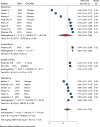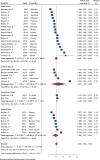Plasmodium falciparum genetic diversity and multiplicity of infection based on msp-1, msp-2, glurp and microsatellite genetic markers in sub-Saharan Africa: a systematic review and meta-analysis
- PMID: 38589874
- PMCID: PMC11000358
- DOI: 10.1186/s12936-024-04925-y
Plasmodium falciparum genetic diversity and multiplicity of infection based on msp-1, msp-2, glurp and microsatellite genetic markers in sub-Saharan Africa: a systematic review and meta-analysis
Abstract
Background: In sub-Saharan Africa (SSA), Plasmodium falciparum causes most of the malaria cases. Despite its crucial roles in disease severity and drug resistance, comprehensive data on Plasmodium falciparum genetic diversity and multiplicity of infection (MOI) are sparse in SSA. This study summarizes available information on genetic diversity and MOI, focusing on key markers (msp-1, msp-2, glurp, and microsatellites). The systematic review aimed to evaluate their influence on malaria transmission dynamics and offer insights for enhancing malaria control measures in SSA.
Methods: The review was conducted following the Preferred Reporting Items for Systematic Review and Meta-Analysis (PRISMA) guidelines. Two reviewers conducted article screening, assessed the risk of bias (RoB), and performed data abstraction. Meta-analysis was performed using the random-effects model in STATA version 17.
Results: The review included 52 articles: 39 cross-sectional studies and 13 Randomized Controlled Trial (RCT)/cohort studies, involving 11,640 genotyped parasite isolates from 23 SSA countries. The overall pooled mean expected heterozygosity was 0.65 (95% CI: 0.51-0.78). Regionally, values varied: East (0.58), Central (0.84), Southern (0.74), and West Africa (0.69). Overall pooled allele frequencies of msp-1 alleles K1, MAD20, and RO33 were 61%, 44%, and 40%, respectively, while msp-2 I/C 3D7 and FC27 alleles were 61% and 55%. Central Africa reported higher frequencies (K1: 74%, MAD20: 51%, RO33: 48%) than East Africa (K1: 46%, MAD20: 42%, RO33: 31%). For msp-2, East Africa had 60% and 55% for I/C 3D7 and FC27 alleles, while West Africa had 62% and 50%, respectively. The pooled allele frequency for glurp was 66%. The overall pooled mean MOI was 2.09 (95% CI: 1.88-2.30), with regional variations: East (2.05), Central (2.37), Southern (2.16), and West Africa (1.96). The overall prevalence of polyclonal Plasmodium falciparum infections was 63% (95% CI: 56-70), with regional prevalences as follows: East (62%), West (61%), Central (65%), and South Africa (71%).
Conclusion: The study shows substantial regional variation in Plasmodium falciparum parasite genetic diversity and MOI in SSA. These findings suggest a need for malaria control strategies and surveillance efforts considering regional-specific factors underlying Plasmodium falciparum infection.
Keywords: Plasmodium falciparum; Genetic diversity and multiplicity of infection; Sub-Saharan Africa.
© 2024. The Author(s).
Conflict of interest statement
The authors declare that they have no competing interests.
Figures




References
-
- WHO . World Malaria Report 2023. Geneva: World Health Organization; 2023.
Publication types
MeSH terms
Substances
Grants and funding
LinkOut - more resources
Full Text Sources
Research Materials

